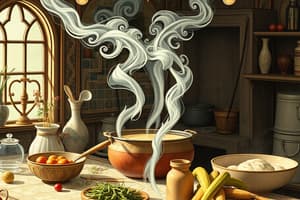Podcast
Questions and Answers
The essential part of stock that is a mixture of coarsely chopped onions, carrots, and celery is called:
The essential part of stock that is a mixture of coarsely chopped onions, carrots, and celery is called:
- Bouquet garni
- Aromatics
- Sachet d'épices
- Mirepoix (correct)
What liquid is usually used for making stock?
What liquid is usually used for making stock?
Water
Roasting bones to enhance the flavor and color of stock is a process known as:
Roasting bones to enhance the flavor and color of stock is a process known as:
- Sweating
- Parboiling
- Browning (correct)
- Blanching
The ratio of liquid to flavoring ingredients in vegetable stock is:
The ratio of liquid to flavoring ingredients in vegetable stock is:
After the stock has been stored, it must have the fat removed before it can be used. This is because?
After the stock has been stored, it must have the fat removed before it can be used. This is because?
Béchamel, velouté, and hollandaise are all called?
Béchamel, velouté, and hollandaise are all called?
A slurry, a liaison, and a roux are all considered to be:
A slurry, a liaison, and a roux are all considered to be:
What is a mixture of egg yolks and heavy cream that adds a rich flavor and velvety smoothness to the sauce without making it too thick?
What is a mixture of egg yolks and heavy cream that adds a rich flavor and velvety smoothness to the sauce without making it too thick?
Stocks, broths, and consommés are all what type of soup?
Stocks, broths, and consommés are all what type of soup?
Thick soups can be thickened with:
Thick soups can be thickened with:
What is blanching?
What is blanching?
List the four essential parts of stock:
List the four essential parts of stock:
Why are stocks often referred to as the cook's 'building blocks'?
Why are stocks often referred to as the cook's 'building blocks'?
What are the various types of stocks?
What are the various types of stocks?
What are the three methods for preparing bones for stock?
What are the three methods for preparing bones for stock?
How and why do you remove fat from stock?
How and why do you remove fat from stock?
What is the proper way in which to cool stock?
What is the proper way in which to cool stock?
What are the two basic kinds of soup?
What are the two basic kinds of soup?
What are the four essential parts of a stock and the proper ingredients for each?
What are the four essential parts of a stock and the proper ingredients for each?
What are the five classical mother sauces?
What are the five classical mother sauces?
Study Notes
Stocks
- Mirepoix: Essential flavor base made from coarsely chopped onions, carrots, and celery.
- Primary Liquid: Water is typically used for making stock.
- Browning: The process of roasting bones to enhance stock's flavor and color.
- Vegetable Stock Ratio: 4 pounds of vegetables to 4 quarts of water yields 1 gallon of stock.
- Degreasing Importance: Removes fat from stock, resulting in a clearer, purer product.
- Types of Stocks: Includes white stock, brown stock, fumet, court bouillon, glace, remouillage, bouillon, jus, and vegetable stock.
Soups
- Clear Soups: Stocks, broths, and consommés classified under this category.
- Thick Soups: Can be thickened using cornstarch among other methods.
- Two Basic Kinds of Soup: Clear soups and thick soups.
Sauces
- Mother Sauces: Béchamel, Velouté, Espagnole, Tomato, and Hollandaise are the five classical mother sauces.
- Thickening Agents: Include slurry, liaison, and roux, all of which are considered thickeners.
- Liaison: A mixture of egg yolks and heavy cream that enriches sauces without adding excessive thickness.
Culinary Techniques
- Blanching: Scalding in boiling water briefly, then cooling in ice water for preservation or preparation.
- Fat Removal: Fat is removed from cooled stock by skimming the hardened layer from the surface to enhance clarity.
- Stock Cooling Method: Use an ice water bath or transfer into smaller, shallow containers for rapid cooling.
Key Components of Stock
- Four essential parts:
- Major flavoring ingredient,
- Liquid (often water),
- Mirepoix (carrots, celery, and onions),
- Aromatics (including thyme, bay leaf, parsley, peppercorns).
Importance of Stocks
- Often referred to as the cook's "building blocks," stocks serve as a foundational element for many soups and sauces.
Studying That Suits You
Use AI to generate personalized quizzes and flashcards to suit your learning preferences.
Description
Test your knowledge of stocks, soups, and sauces with these flashcards from Chapter 17. Explore key terms and definitions related to essential ingredients and processes in culinary arts. Perfect for culinary students and enthusiasts looking to deepen their understanding of foundational cooking techniques.




